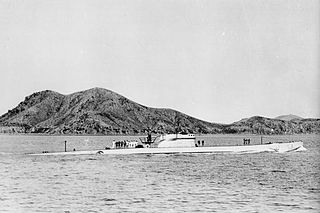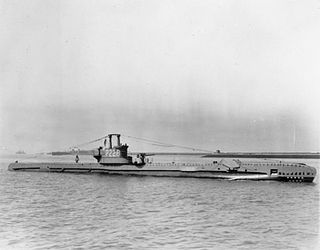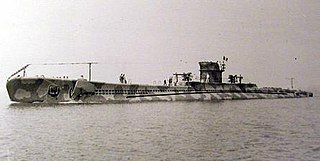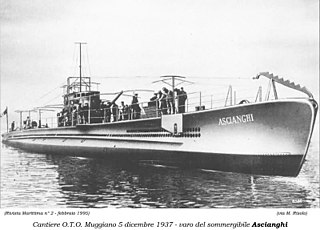
This is a timeline for the Battle of the Atlantic (1939–1945) in World War II.

The Battle of the Mediterranean was the name given to the naval campaign fought in the Mediterranean Sea during World War II, from 10 June 1940 to 2 May 1945.

HMS Safari was a third batch S-class submarine built for the Royal Navy during World War II. Commissioned in 1942, she was assigned to operate in the Mediterranean Sea. During the course of the war, Safari sank twenty-five ships, most of which were Italian.

HMS Tuna (N94) was a T-class submarine of the Royal Navy. She was laid down by Scotts, Greenock and launched on 10 May 1940. She was equipped with German-built MAN Diesel engines and spent her career in World War II in western European waters, in the North Sea and off the west coast of France, and most famously taking part in Operation Frankton.

The Shoreham-class sloops were a class of eight warships of the Royal Navy built in the early 1930s.

Barbarigo was a World War II Italian Marcello-class submarine. It was built by the Cantieri Riuniti dell'Adriatico, and was commissioned on 19 September 1938.

The Marcello class was a class of nine submarines built in 1937 and 1938 by CRDA in Trieste for the Royal Italian Navy. Two similar submarines built in 1939 at La Spezia by Oto Melara are sometimes considered part of the class. All eleven served in the Mediterranean Sea at the start of the Second World War. After Provana's 1940 sinking, the remaining boats were transferred to the BETASOM Atlantic submarine base at Bordeaux in August 1940. After four boats had been sunk in the Atlantic, Barbarigo and Comandante Cappellini were then selected for conversion to "transport submarines" in order to exchange rare or irreplaceable trade goods with Japan. Cargo capacity of 160 tons reduced reserve buoyancy from 20–25% to 3.5–6%; and armament was reduced to defensive machine guns. Only Dandolo was in operational condition at the end of the war.

HMS Splendid was a third-batch S-class submarine built for the Royal Navy during World War II. She was laid down on 7 March 1941 and launched on 19 January 1942. After an initial patrol through the Bay of Biscay to Gibraltar, Splendid conducted two patrols in the Mediterranean Sea; one was abandoned after technical problems and on the other she sank two Italian ships. On her next patrol, the submarine attacked two Italian convoys, sinking an Italian destroyer in the second attack. Based in Algiers, the boat operated north of Sicily, sinking six Italian ships, including two tankers and two heavy merchant ships. Splendid was detected by a German destroyer on 21 April 1943 while patrolling off Naples, Italy; the submarine was attacked with depth charges by the destroyer and forced to surface, after which she was scuttled and her surviving crew members taken prisoner. She was the most successful British submarine by tonnage sunk between November 1942 and May 1943.

BETASOM was a submarine base established at Bordeaux, France by the Regia Marina during the Second World War. From this base, Italian submarines participated in the Battle of the Atlantic from 1940 to 1943 as part of the Axis anti-shipping campaign against the Allies.

The Cagni or Ammiraglio Cagni class was a class of submarines built for Italy's Regia Marina during World War II.

Leonardo da Vinci was a Marconi-class submarine of the Italian navy during World War II. It operated in the Atlantic from September 1940 until its loss in May 1943, and became the top scoring non-German submarine of the entire war.
The Italian submarine fleet of World War II was the largest in the world at the time, with 116 submarines. It saw action during the Second World War, serving mainly in the Mediterranean. During the conflict 88 submarines, 75% of its total strength, were lost.

Arctic naval operations of World War II were the World War II naval operations that took place in the Arctic Ocean, and can be considered part of the Battle of the Atlantic and/or of the European Theatre of World War II.

The Calvi class was a class of three submarines built by Oderno-Terni-Orlando in Genoa for the Royal Italian Navy. The submarines were built in 1935, and all three served in the Mediterranean at the start of the Second World War. The boats were transferred to the BETASOM Atlantic submarine base at Bordeaux in August 1940. In December 1941 the boats were used for a rescue mission of 254 sailors from the sunken German auxiliary cruiser Atlantis. After Calvi had been sunk, Finzi and Tazzoli were selected for conversion to "transport submarines" in order to exchange rare or irreplaceable trade goods with Japan. Cargo capacity of 160 tons reduced reserve buoyancy from 20–25% to 3.5–6%; and armament was reduced to defensive machine guns.

The Argo-class was a class of two coastal submarines built by Cantieri Riuniti dell'Adriatico in Monfalcone for Portugal but operated by the Royal Italian Navy after Portugal was unable to pay construction costs. The submarines were built in 1936, and both served in the Mediterranean Sea at the start of the Second World War. The boats were transferred to the BETASOM Atlantic submarine base at Bordeaux in 1940, but returned to the Mediterranean in 1941, where both were sunk within a few days of the September 1943 Italian armistice.
Giuseppe Finzi was one of three Calvi-class submarines built for the Regia Marina during the 1930s. Completed in 1936, she played a minor role in the Spanish Civil War of 1936–1939 supporting the Spanish Nationalists. The submarine made multiple patrols in the Atlantic Ocean during the Second World War, sinking five Allied ships. Gisueppe Finzi began conversion into a transport submarine in 1943, but was captured by the Germans in September 1943 before it was completed and redesignated as UIT-21. She was scuttled by them in August 1944 to prevent her capture.
Pietro Calvi was the lead ship of its class of two submarines built for the Regia Marina during the 1930s. Completed in 1936, she played a minor role in the Spanish Civil War of 1936–1939 supporting the Spanish Nationalists. The submarine made multiple patrols in the Atlantic Ocean during the Second World War, sinking seven Allied ships. Pietro Calvi was rammed and sunk by a British convoy escort in July 1942.

Italian submarine Ascianghi was an Adua-class submarine built for the Royal Italian Navy during the 1930s. It was named after Lake Ashenge in Ethiopia.
Guglielmotti was a Brin-class submarine built for the Royal Italian Navy during the 1930s.
World War II was the first war where naval aviation took a major part in the hostilities. Aircraft carriers were used from the start of the war in Europe looking for German merchant raiders and escorting convoys. Offensive operations began with the Norwegian campaign where British carriers supported the fighting on land.














